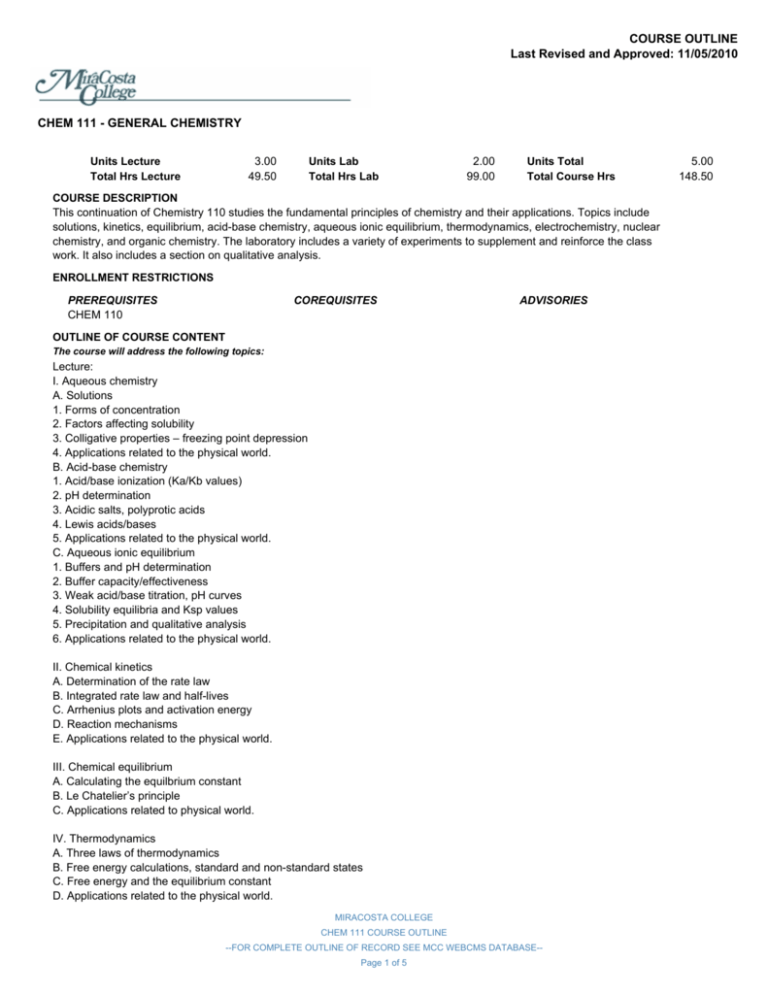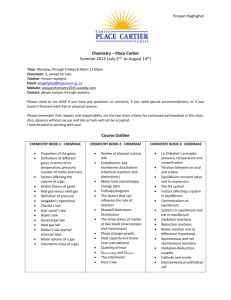
COURSE OUTLINE
Last Revised and Approved: 11/05/2010
CHEM 111 - GENERAL CHEMISTRY
Units Lecture
Total Hrs Lecture
3.00
49.50
Units Lab
Total Hrs Lab
2.00
99.00
Units Total
Total Course Hrs
COURSE DESCRIPTION
This continuation of Chemistry 110 studies the fundamental principles of chemistry and their applications. Topics include
solutions, kinetics, equilibrium, acid-base chemistry, aqueous ionic equilibrium, thermodynamics, electrochemistry, nuclear
chemistry, and organic chemistry. The laboratory includes a variety of experiments to supplement and reinforce the class
work. It also includes a section on qualitative analysis.
ENROLLMENT RESTRICTIONS
PREREQUISITES
CHEM 110
COREQUISITES
ADVISORIES
OUTLINE OF COURSE CONTENT
The course will address the following topics:
Lecture:
I. Aqueous chemistry
A. Solutions
1. Forms of concentration
2. Factors affecting solubility
3. Colligative properties – freezing point depression
4. Applications related to the physical world.
B. Acid-base chemistry
1. Acid/base ionization (Ka/Kb values)
2. pH determination
3. Acidic salts, polyprotic acids
4. Lewis acids/bases
5. Applications related to the physical world.
C. Aqueous ionic equilibrium
1. Buffers and pH determination
2. Buffer capacity/effectiveness
3. Weak acid/base titration, pH curves
4. Solubility equilibria and Ksp values
5. Precipitation and qualitative analysis
6. Applications related to the physical world.
II. Chemical kinetics
A. Determination of the rate law
B. Integrated rate law and half-lives
C. Arrhenius plots and activation energy
D. Reaction mechanisms
E. Applications related to the physical world.
III. Chemical equilibrium
A. Calculating the equilbrium constant
B. Le Chatelier’s principle
C. Applications related to physical world.
IV. Thermodynamics
A. Three laws of thermodynamics
B. Free energy calculations, standard and non-standard states
C. Free energy and the equilibrium constant
D. Applications related to the physical world.
MIRACOSTA COLLEGE
CHEM 111 COURSE OUTLINE
--FOR COMPLETE OUTLINE OF RECORD SEE MCC WEBCMS DATABASE-Page 1 of 5
5.00
148.50
COURSE OUTLINE
Last Revised and Approved: 11/05/2010
V. Electrochemistry
A. Predicting reaction spontaneity
B. Free energy and cell potential
C. Applications related to the physical world.
VI. Nuclear chemistry
A. Balancing nuclear reactions
B. Radiocarbon dating, kinetics
C. Fission and fusion
D. Applications related to the physical world.
VII. Organic chemistry
A. Alkanes, alcohols
B. Aromatics, benzene
C. Applications related to the physical world.
Lab: All experiments performed in the laboratory portion of the class are designed to complement and support topics
presented in lecture. Timing is such that students perform the experiment after the topic has been introduced and
developed in lecture so that students are familiar with the subject. During the first 15-20 minutes of the experiment, theory
and specifics are addressed. The specific contents of the laboratory are included below:
I. Introduction to the laboratory environment

A. Laboratory safety

B. Scientific inquiry
 and statistical analysis of data.
II. Aqueous chemistry
A. Concentrations of solutions
B. Molar mass determination through freezing point depression
C. Dissociation constant of weak acid
D. Buffer solutions
E. Qualitative analysis and precipitation.
III. Chemical Kinetics: Determination of the rate law for a reaction
IV. Chemical equilibrium
A. Evaluating the equilibrium constant
B. Le Chatelier’s principle.
V. Thermodynamics of a salt dissolving in water
VI. Electrochemical cells.
PERFORMANCE OBJECTIVES
Upon successful completion of this course, students will be able to do the following:
1). Identify and differentiate among the different forms of solutions; select the appropriate method for preparing a solution
and quantify the amounts of substances required
2). Analyze the physical environmental and molecular factors affecting solubility and then use this knowledge to predict
miscibility and solubility of solutes and solvents
3). Illustrate and describe the concepts of colligative properties and apply this knowledge to compute the molar mass of an
unknown compound
4). Evaluate initial concentration and reaction rate data to formulate the chemical kinetic rate law and dependence of the
rate on a specific reactant
5). Analyze chemical kinetic data graphically relating concentration vs. time to predict the kinetic integrated rate law and the
order of reaction; compute the half-life and remaining concentration at a given time using the integrated rate law
6). Identify and describe various chemical equilibrium systems including gas phase, aqueous phase, acid/base-buffer,
MIRACOSTA COLLEGE
CHEM 111 COURSE OUTLINE
--FOR COMPLETE OUTLINE OF RECORD SEE MCC WEBCMS DATABASE-Page 2 of 5
COURSE OUTLINE
Last Revised and Approved: 11/05/2010
solubility, and complex ion systems, and use this knowledge to predict and compute equilibrium constants, pH, precipitation,
and equilibrium concentrations
7). Examine chemical systems at equilibrium and qualitatively predict the effect of changes in concentration, pressure, and
temperature imposed on a system using Le Chatelier's principle
8). Compare, identify and describe the properties and strengths of various types of acids and bases based on chemical and
structural principles
9). Analyze and quantify entropy, enthalpy, and the free energy exchange in various chemical systems at standard and
non-standard states to predict reaction spontaneity
10). Analyze and quantify the cell potential for a chemical oxidation-reduction system at standard and non-standard states to
predict reaction spontaneity
11). Apply the 1st order kinetics integrated rate law theory to nuclear chemical reactions and calculate the remaining
concentration of radioactive substance or predict the amount of time required to decompose to a specific value
12). Describe and evaluate the impact nuclear reactions have on science and society
13). Safely and effectively operate laboratory equipment (e.g., burets, pipets, balances, volumetric flasks, Bunsen burners,
hot plates, Spec 20) using proper techniques for handling chemicals and equipment
14). Analyze and interpret data through graphical means to draw conclusions that support or refute scientific hypotheses.
READING ASSIGNMENTS
Reading assignments will be consistent with, but not limited by, the following types and examples:
1). Read assigned sections of the course textbook with emphasis on relevant terminology and symbolic representation,
molecular-level and macroscopic-level illustrations that explain the theory, causal factors that support the theory, and
samples of worked problems
2). Read assigned scientific articles found in science journals, news magazines, or reliable Internet sites to expand
understanding in lecture or laboratory arenas and/or for specific projects
3). Read assigned sections of course textbook for the laboratory with emphasis on safety and illustrations for proper
handling techniques of chemicals
4). Read and deconstruct assigned course laboratory experiments for understanding and reconstructing detailed
instructions into the lab notebook.
WRITING ASSIGNMENTS
Writing assignments will be consistent with, but not limited by, the following types and examples:
1). Complete comprehensive and frequent homework assignments from the text that include cause and effect arguments,
explanations and descriptions, illustrations, and considerable mathematical computations, analysis, and graphing
2). Take extensive notes and write short essays that develop and defend concepts in scientific theory, in addition to
organization and pattern development for problem-solving and mathematical computations
3). Document data and observations entries in the lab notebook as consistent with laboratory experiments and activities
4). Tabulate data, prepare graphical and statistical analyses, organize results, assimilate information, and synthesize
arguments that support or refute scientific hypotheses as part of the laboratory experience.
OUTSIDE-OF-CLASS ASSIGNMENTS (READING/WRITING/OTHER)
Outside-of-class assignments will be consistent with, but not limited by, the following types and examples:
1). Conclude extensive reading assignments from the course textbook and from supplemental reading sources, such as
scientific journals, news magazines, or Internet sites
2). Conclude extensive writing assignments from textbook related homework, research papers, or reflective papers
3). Complete calculations and other quantitative and qualitative problem-solving assignments from the textbook
4). Complete calculations and other quantitative and qualitative problem-solving assignments from lab activities
5). Study and assimilate content learned in lecture and laboratory, along with supporting materials such as study guides,
handouts, practice tests and questions, in preparation for tests
6). Read and assimilate detailed instructions for laboratory activities; parse experimental procedure and rewrite using
original wording into the laboratory notebook before actual experiment is performed
7). Organize qualitative and quantitative data, describe conditions and techniques, analyze results and draw conclusions to
formulate the comprehensive lab report.
STUDENT LEARNING OUTCOMES
Learning Outcome
1.
Mode of Assessment
Students will analyze "concentration vs. time" data for a
1.
Written calculation and graphing problem on exam or
MIRACOSTA COLLEGE
CHEM 111 COURSE OUTLINE
--FOR COMPLETE OUTLINE OF RECORD SEE MCC WEBCMS DATABASE-Page 3 of 5
COURSE OUTLINE
Last Revised and Approved: 11/05/2010
given chemical reaction, graph the data according to
the integrated rate laws, and use the results to write the
complete differential rate law for the reaction.
lab quiz/exam, including showing all work step-by-step.
Students will be given a table of "concentration vs.
time" data, and instructed to graph the data according
to the integrated rate laws. The students will also be
instructed to interpret the graphs and use the results to
write the complete differential rate law for the reaction.
2.
Students will analyze the composition of a given buffer
system, and calculate either the pH of the buffer if given
the concentrations of the components, or calculate the
necessary concentrations if given the pH.
2.
Written calculation question on exam, including explicit
demonstration of problem-solving (“show your work”).
Students will be given a periodic table, appropriate
values of Ka or pKa, the identity of the conjugate acid
and base in the buffer system, and instructed to either:
calculate the pH, if the concentrations of the conjugate
acid and base are given; or calculate the necessary
concentrations, if the pH is given.
3.
Students will analyze a chemical system at equilibrium
in order to calculate the standard free energy change
(G°) for the reaction, and to calculate the free
energy change (G) for the same reaction at
given non-standard conditions; students will use the
results of these calculations to predict the spontaneous
direction of the reaction at the given nonstandard
conditions.
3.
Written calculation and essay problem on exam or lab
quiz/exam, including showing all work step-by-step.
Students will be given the value of the equilibrium
constant for a particular reaction and instructed to
calculate the standard free energy change for the
reaction. Students will also be given specific
non-standard conditions for the reaction and instructed
to calculate the free energy change of the reaction at
these non-standard conditions. Finally, students will be
instructed to use compare the results of the two
calculations to predict and explain the spontaneous
direction of the reaction at the non-standard conditions.
METHODS OF INSTRUCTION
Instructional methodologies will be consistent with, but not limited by, the following types or examples:
1). Lecture - Traditional and interactive one-on-one tutorial in class during problem-solving sessions supplemented with one
or more of the following: PowerPoint slides, overhead transparencies, hand-drawn illustrations on the board, handouts
2). Group discussion and analysis of problems
3). Think pair-share methodology
4). Collaborative exercises
5). Laboratory - Traditional lecture, group discussion, collaborative activities, individual instruction.
METHODS OF EVALUATION
Evaluation methodologies will be consistent with, but not limited by, the following types or examples:
1). Exams or tests including multiple choice, fill-in-the-blank, calculations, scientific reasoning, problem-solving, description
and illustration, application and explanation of concepts and phenomena covered in the content outline
2). Projects (such as individual and/or group research or reflection papers, and/or presentations)
3). Written homework, including calculations, scientific reasoning, problem-solving, description and illustration, application
and explanation of concepts and phenomena covered in content outline
4). Quizzes
5). Lab notebook preparation
6). Lab reports.
REQUIRED TEXTBOOKS
Examples of typical textbooks for this course include the following:
1). Tro, Nivaldo J. Chemistry: A Molecular Approach. 2nd ed., Pearson Prentice Hall, 2011. ISBN: 978-0321651785
2). Stanitski, Conrad L., et al. Laboratory Handbook for General Chemistry. 3rd ed., Thomson, Brooks/Cole, 2007. ISBN:
978-0495018902
OTHER REQUIRED INSTRUCTIONAL MATERIALS
1). Chemical Education Resources. Lab Experiments for CHEM 111
2). Safety goggles
MIRACOSTA COLLEGE
CHEM 111 COURSE OUTLINE
--FOR COMPLETE OUTLINE OF RECORD SEE MCC WEBCMS DATABASE-Page 4 of 5
COURSE OUTLINE
Last Revised and Approved: 11/05/2010
3). Quadrille notebook for lab
4). Chemical resistant gloves
5). Scientific non-graphing calculator.
COURSE REPEATABILITY
Total Completions Allowed:
1
In Combination With:
MIRACOSTA COLLEGE
CHEM 111 COURSE OUTLINE
--FOR COMPLETE OUTLINE OF RECORD SEE MCC WEBCMS DATABASE-Page 5 of 5







